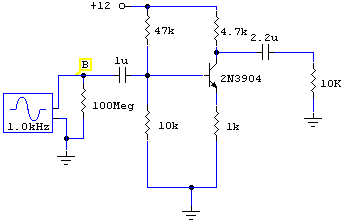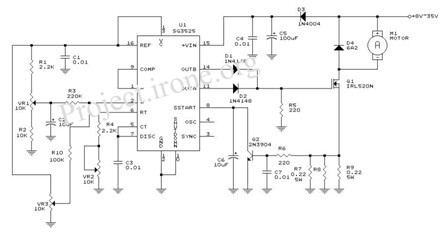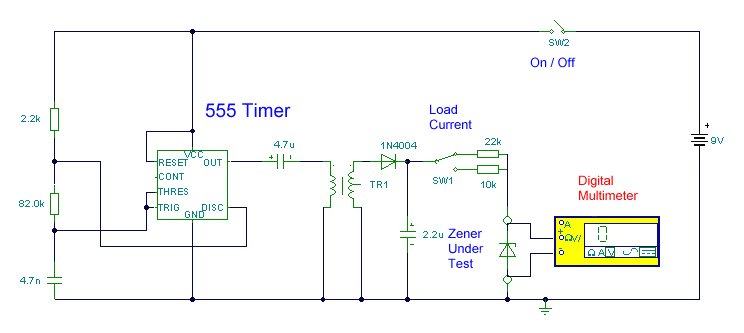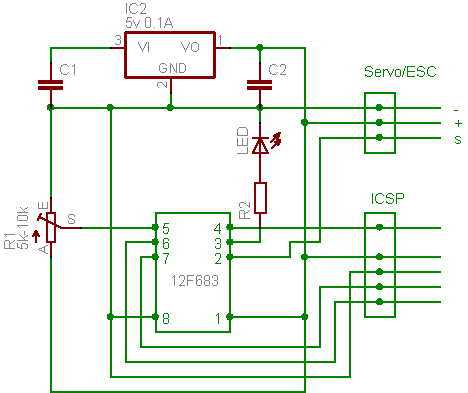
RC relaxation type tone control circuit
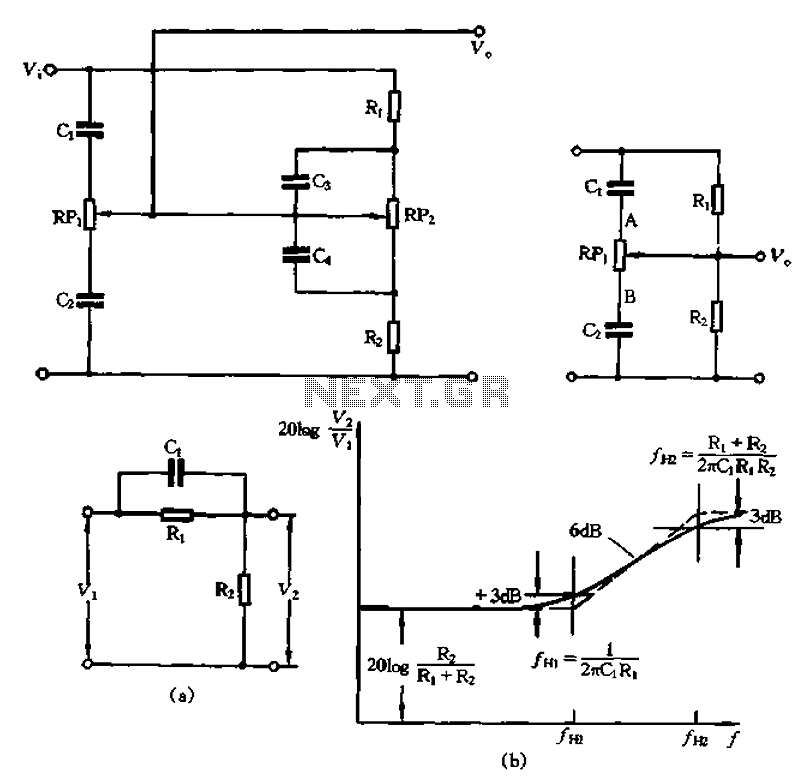
The circuit illustrated in Figure 1-560 represents a treble control potentiometer. Due to the larger capacitance values of C3 and C4 compared to C1 and C2, high-frequency signals can treat C4 as a short circuit. Consequently, the treble adjustment circuit can be simplified as shown in Figure 1-57. When the potentiometer arm is positioned at point A, the resistance of RPi is significantly greater than Rz, rendering the RPi, C2 branch as open. Thus, Figure 1-57 can be equated to Figure 1-58 (a). In this configuration, the components responsible for bass and midrange (C1) can also be considered open, resulting in a relatively low frequency. The voltage ratio V2/V1 is influenced by the resistances Ri and Rz, with the circuit enabling high-frequency signals to pass through due to the small capacitance. As frequency increases beyond a certain threshold, C1 can be treated as a short circuit, making V2 nearly equal to V1. Figure 1-58 (b) illustrates the enhanced characteristics of the circuit, where the solid line represents the precise control characteristics and the dotted line indicates an approximation. The treble frequency adjustment begins at fHI = 1/(2πC1Ri), establishing the starting point for frequency adjustment, where a signal increase of approximately 6 dB corresponds to a doubling of frequency. The characteristic curve flattens at the corner frequency H2 = (Ri + Rz)/2, with the assumption that Ri is 10 times Rz. When the frequency increases tenfold, the transmission voltage relative to the increase reaches 20 dB (10 times).
The treble control potentiometer circuit is designed to adjust high-frequency audio signals, enhancing the overall sound quality by allowing for specific frequency manipulation. The core components include a potentiometer, resistors, and capacitors, which work together to filter and amplify audio signals. The potentiometer (RPi) serves as the primary control element, enabling users to adjust the treble frequencies according to their preferences.
In this circuit, the interaction between the resistors and capacitors determines the frequency response. The larger capacitors (C3 and C4) effectively short-circuit high-frequency signals, allowing them to pass through while attenuating lower frequencies. This selective filtering creates a treble boost when the potentiometer is adjusted towards the high-frequency end. The relationship between resistance and capacitance is critical; as the resistance of RPi increases, the circuit behaves as an open circuit for lower frequencies, effectively removing bass and midrange components from the output.
The voltage gain characteristics of the circuit, as illustrated in Figure 1-58, demonstrate how the gain increases with frequency. The solid line in the figure indicates the actual gain behavior, while the dotted line provides a simplified approximation. The corner frequency, where the gain starts to flatten, is determined by the combined effects of the resistors and capacitors in the circuit.
Overall, this treble control circuit allows for precise audio adjustments, enabling users to enhance their listening experience by tailoring the high-frequency response to their specific needs. The careful selection of component values and the arrangement of the circuit elements ensure effective performance in various audio applications. Circuit shown in Figure 1-560 RPi is treble control potentiometer. Because C3, C4 is larger than cl, C2 capacity, so high-frequency signals, Pat, C4 can be regarded as a short circuit. So treble adjustment circuit can be simplified as in Figure 1-57. When the arm is moved to the top RPi point A, due RPi resistance is much greater than Rz, RPI, C2 branch can be regarded as open, so Figure 1-57 can be equivalent to FIG. 1-58 (a). Because cl terms of bass and midrange, can be regarded as open, so the frequency rate is relatively low, V2/V1 foot 2 Ri + 2 feet) 0 Figure 1-58 (a) for high frequency, q the capacitance is very small, high-frequency signal number can go through, and therefore, with respect to the volume treble bass t is increased.
when the frequency is high to a certain extent, ct can be regarded as a short circuit, V2 is almost equal to the o Figure 1 - VI 58 (b) to enhance the properties (a) circuit curve, solid line is the exact value of the control characteristics of the dotted line is an approximation. start turning the treble frequencies fHI 1/2 rrClRi, whereby point start, frequency per liter twice as high lift signal increases about 6dB;, annoyed by the lift characteristic curve into a flat corner frequency, H2 (Ri + Rz)/2, arRiRzC1 Assuming that Ri 10R2, then when, iO.
when the frequency increases 10 times larger than the transmission voltage relative increase 20dB (10 times).
The treble control potentiometer circuit is designed to adjust high-frequency audio signals, enhancing the overall sound quality by allowing for specific frequency manipulation. The core components include a potentiometer, resistors, and capacitors, which work together to filter and amplify audio signals. The potentiometer (RPi) serves as the primary control element, enabling users to adjust the treble frequencies according to their preferences.
In this circuit, the interaction between the resistors and capacitors determines the frequency response. The larger capacitors (C3 and C4) effectively short-circuit high-frequency signals, allowing them to pass through while attenuating lower frequencies. This selective filtering creates a treble boost when the potentiometer is adjusted towards the high-frequency end. The relationship between resistance and capacitance is critical; as the resistance of RPi increases, the circuit behaves as an open circuit for lower frequencies, effectively removing bass and midrange components from the output.
The voltage gain characteristics of the circuit, as illustrated in Figure 1-58, demonstrate how the gain increases with frequency. The solid line in the figure indicates the actual gain behavior, while the dotted line provides a simplified approximation. The corner frequency, where the gain starts to flatten, is determined by the combined effects of the resistors and capacitors in the circuit.
Overall, this treble control circuit allows for precise audio adjustments, enabling users to enhance their listening experience by tailoring the high-frequency response to their specific needs. The careful selection of component values and the arrangement of the circuit elements ensure effective performance in various audio applications. Circuit shown in Figure 1-560 RPi is treble control potentiometer. Because C3, C4 is larger than cl, C2 capacity, so high-frequency signals, Pat, C4 can be regarded as a short circuit. So treble adjustment circuit can be simplified as in Figure 1-57. When the arm is moved to the top RPi point A, due RPi resistance is much greater than Rz, RPI, C2 branch can be regarded as open, so Figure 1-57 can be equivalent to FIG. 1-58 (a). Because cl terms of bass and midrange, can be regarded as open, so the frequency rate is relatively low, V2/V1 foot 2 Ri + 2 feet) 0 Figure 1-58 (a) for high frequency, q the capacitance is very small, high-frequency signal number can go through, and therefore, with respect to the volume treble bass t is increased.
when the frequency is high to a certain extent, ct can be regarded as a short circuit, V2 is almost equal to the o Figure 1 - VI 58 (b) to enhance the properties (a) circuit curve, solid line is the exact value of the control characteristics of the dotted line is an approximation. start turning the treble frequencies fHI 1/2 rrClRi, whereby point start, frequency per liter twice as high lift signal increases about 6dB;, annoyed by the lift characteristic curve into a flat corner frequency, H2 (Ri + Rz)/2, arRiRzC1 Assuming that Ri 10R2, then when, iO.
when the frequency increases 10 times larger than the transmission voltage relative increase 20dB (10 times).
Warning: include(partials/cookie-banner.php): Failed to open stream: Permission denied in /var/www/html/nextgr/view-circuit.php on line 713
Warning: include(): Failed opening 'partials/cookie-banner.php' for inclusion (include_path='.:/usr/share/php') in /var/www/html/nextgr/view-circuit.php on line 713
